New Light on Adult Literacy and Numeracy in Scotland: Evidence from the 2004 survey of the 1970 British Cohort Study (BCS70)
This report gives the results of a separate analysis for Scotland of literacy and numeracy data collected in the 1970 British Cohort Study at age 34. It relates performance in these skills to a wide range of other features of Scottish cohort members' lives.
Chapter 8 Home, local environment and community participation
We now turn to the first time Scottish cohort members moved away from their family/parental home to embrace independent living and moving house later on and the reasons behind the move. We conclude this section by looking at their current housing situation, how they feel about where they live, the surrounding local environment and their engagement with it.
Leaving the family home for the first time
8% of men and 9% of women had left the family home by 16 or 17, with women with SCQF Access Level 2 or 3 literacy being the most likely to (15%). 41% of women with SCQF Access Level 2 or 3 literacy had moved away from their parents before they were 20. However, men and women with SCQF Level 5 or higher skills began to move away once they were 18, with the pursuit of tertiary education or training opportunities presumably being behind many of these moves.
Moving On
By the time cohort members were 34, men and women with SCQF Level 5 or higher skills were the most likely to have moved home on a number of occasions. Since age 16, men and women had, on average, lived in four different homes. This was highest at 5 for men and women with SCQF Level 5 or higher literacy or numeracy skills and lowest at 3 for men with SCQF Access Level 2 or 3 literacy. This could either be perceived as men and women with the lowest skills having a relatively stable home environment or that they have not had the financial ability - or opportunity - to take advantage of the economic and lifestyle rewards that moves in the housing market over the last decade or so have generally given.
Looking further into the reasons behind these moves, we found that among cohort members who had ever moved home more than 6 in 10 had moved at least once as they wanted a better or bigger home, 4 in 10 because of a relationship breakdown and around 3 in 10 men and 1 in 4 women for reasons to do with work. Men with SCQF Access Level 2 or 3 literacy were less likely to have moved because they wanted a bigger or better home, and were three times less likely to have moved twice or more to get a bigger/better home, compared with men with SCQF Level 5 skills (6% to 19% literacy, 7% to 21% numeracy). There were no differences across skills groups for women ever moving to get a bigger or better home, but women with SCQF Access Level 2 or 3 literacy were more likely to have moved on two occasions, reflecting their larger family size. Men and women with SCQF Access Level skills were less likely to have moved for reasons to do with work. Whereas 3% of men and women with SCQF Access Level 2 or 3 literacy and 4% of women with SCQF Access Level 2 numeracy skills had moved at least twice for reasons to do with work, this increased around fivefold among those with Level 2 or higher skills (16% men 14% women SCQF Level 5 literacy, 19% men and women SCQF Level 5 numeracy). There were no differences between skills groups in moving due to a relationship breakdown.
Housing conditions at age 34
As in their childhood, men and women with SCQF Access Level literacy or numeracy were most likely to live in disadvantaged housing conditions (rented and or overcrowded) at age 34, compared with men and women with more accomplished skills. Figure 8.1 shows that as many as 62% of women with SCQF Access Level 2 or 3 literacy rented their home compared with 17% women with SCQF Level 5 literacy. Comparable differences by numeracy were 46% to 11%. 1 in 5 men and 1 in 3 women with SCQF Access Level 2 or 3 literacy lived in overcrowded housing conditions (more than 1 person per room) compared with no more than 1 in 10 men and 1 in 14 women with SCQF Level 5 literacy and just 1 in 33 women with SCQF Level 5 numeracy. Differences between skills groups were much wider within the Central Belt area than in other parts of Scotland, reflecting the higher house prices and far less space that is characteristic of all urban/metropolitan areas in the UK. Within the Central Belt, men and women with SCQF Access Level 2 or 3 literacy were nearly four times more likely to live in overcrowded accommodation than men and women with SCQF Level 5 skills (34% to 9%). In other areas of Scotland, men and women with SCQF Access Level 2 or 3 literacy were two and a half times more likely to live in overcrowded accommodation than men and women with SCQF Level 5 skills (20% to 8%).
Figure 8.1: Literacy and home life
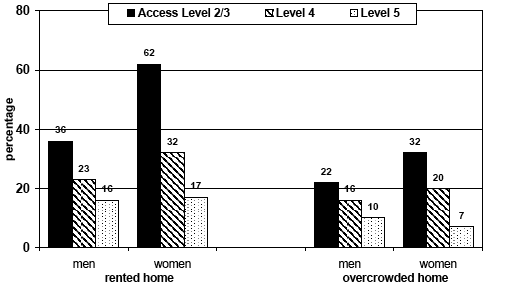
Homelessness
4% of all men and 6% of all women had experienced at least one spell of homelessness. This was highest among women with SCQF Access Level 2 or 3 literacy or SCQF Access Level 2 numeracy (13% and 8% respectively) - more than four times the experience of women with SCQF Level 5 or higher skills (3% literacy, 1% numeracy). There were no differences in levels of homelessness across groups for men. When looking at homelessness by where in Scotland men and women currently live, differences between groups was much greater within the Central Belt than elsewhere in Scotland. Among those living in the Central Belt area, 10% of men and women with SCQF Access Level 2 or 3 literacy had been homeless at least once compared with 3% of men and women with SCQF Level 5 of higher literacy. Comparable figures for men and women living outside the Central Belt were 6% and 4% respectively.
Local environment and community participation
For the first time, questions were included in the survey about cohort members' local area. These showed that cohort members with poor literacy and numeracy were more conscious of graffiti, were less likely to trust people living nearby and felt less safe living in their area. All of which points to a relatively poor local environment and lowest levels of what is called 'social capital' 31 for these groups of individuals. Figure 8.2 shows that men and women with SCQF Access Level 2 or 3 literacy and men with SCQF Access Level 2 numeracy were around four times as likely as those with SCQF Level 5 skills to rate graffiti as a 'very big' problem in their area and in Figure 8.3 that they were far more likely to not trust the people who lived around them 'very much' or 'at all'. Men and women with SCQF Access Level 2 or 3 literacy and SCQF Access Level 2 numeracy were also more likely to report they felt 'very unsafe' going out at night. Women with SCQF Access Level 2 or 3 literacy and SCQF Access Level 2 numeracy were also most likely to report that they did not go out at all when it was dark (Figure 8.4).
Figure 8.2: men and women reporting graffiti to be a problem in there area by literacy or numeracy
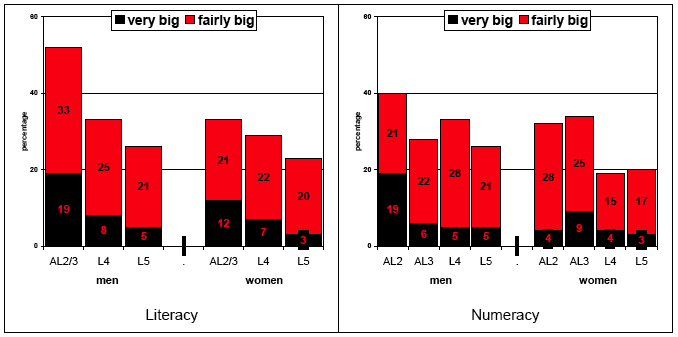
Figure 8.3: men and women reporting they did not trust people in their area by literacy or numeracy
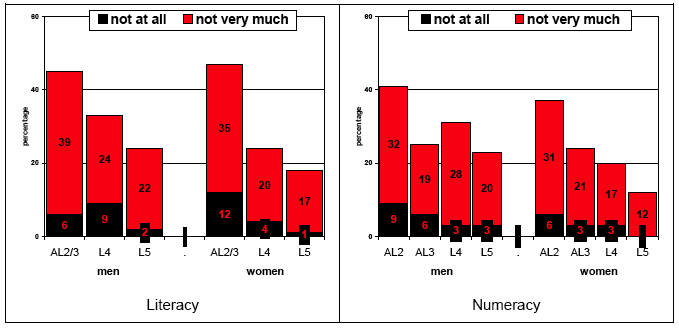
Figure 8.4: men and women reporting they did not feel safe in their area by literacy or numeracy
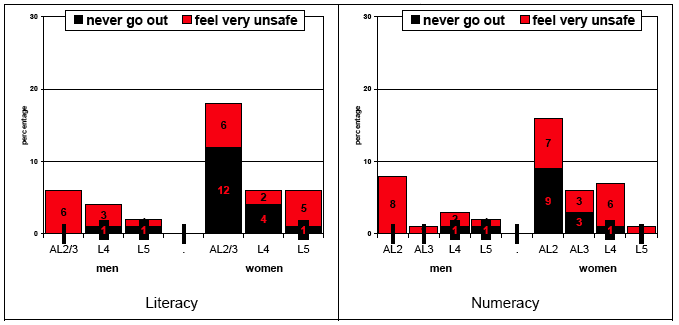
Community and social participation
Community participation or involvement, measured across a variety of activities such as involvement in some sort of community, charitable, interest or activity club or group, or voting, and/or interest in politics, was lowest among men and women with the poorest grasp of literacy or numeracy and lowest of all among men and women with poor skills living within the Central Belt. Figure 8.5 shows that whereas more than 1 in 2 men and women with SCQF Level 5 skills were a member of some group or another, this fell to around 1 in 4 men and women with SCQF Access Level 2 or 3 literacy. Less than 1 in 5 men and women with SCQF Access Level 2 or 3 literacy living within the Central Belt were a member of a group/club.
Voting apathy in the overall population in the 2001 General Election was widespread, matching that found in earlier analysis of BCS70 32. In 2001, 36% of men and 32% of women in Scotland did not vote, very similar to England. The proportion not voting increased to more than 1 in 2 of the men with SCQF Access Level 2 or 3 literacy or SCQF Access Level 2 numeracy (53%). There were no differences across groups for women, as had been found in the original New Light report. However, Figure 8.5 also shows that both men and women with SCQF Access Level 2 or 3 literacy and SCQF Access Level 2 numeracy were at least twice as likely as men and women with SCQF Level 5 literacy or numeracy skills to be 'not at all' interested in politics. Overall, men and women with the poorest grasp of literacy or numeracy in Scotland seemed to be even less enchanted with the political environment than those in BCS70 overall. Within Scotland, differences between literacy groups were once again wider within the Central Belt than other parts of Scotland. 1 in 5 of all men and 1 in 3 of all women had attended a rally, demonstration or signed a petition but men with SCQF Access Level 2 or 3 literacy were five times less likely to (6% to 32%) and women three times less likely to (12% to 36%) than men and women with SCQF Level 5 skills. Again, it was men and women with SCQF Access Level 2 or 3 literacy within the Central Belt that were the least likely to - another example of the exclusion of men and women with the poorest skills within the built-up urban areas (3% to 32% SCQF Level 5 literacy in the Central belt, 14% to 30% SCQF Level 5 literacy elsewhere in Scotland).
Figure 8.5: Literacy, community activity, political interest, petitions
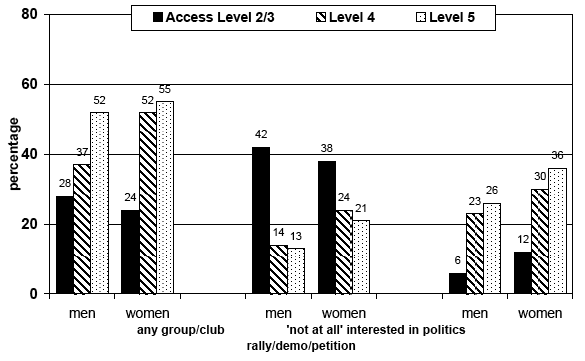
Summary home, local environment and community participation
Men and women with the poorest literacy and numeracy, again particularly literacy, were less likely to have taken advantage of the recently thriving housing market. As in their childhood, they were most likely to be living in rented, overcrowded housing (62% women with SCQF Access Level 2 or 3 literacy compared with 17% SCQF Level 5 literacy lived in rented housing; 32% to 7% in an overcrowded home). Women with poor skills, and those living within the Central Belt, were more likely to have experienced a spell of homelessness (10% with SCQF Access Level 2 or 3 literacy, 3% with SCQF Level 5 literacy in the Central Belt). Questions on local environment revealed that men and women with SCQF Access Level skills were more likely to feel dissatisfied with their local environment or to not trust others living around them. They were generally less engaged with their community, being less involved in clubs, groups or activities or to hold any political interest. Once again, men and women in the Central Belt region appeared the most excluded.
There is a problem
Thanks for your feedback